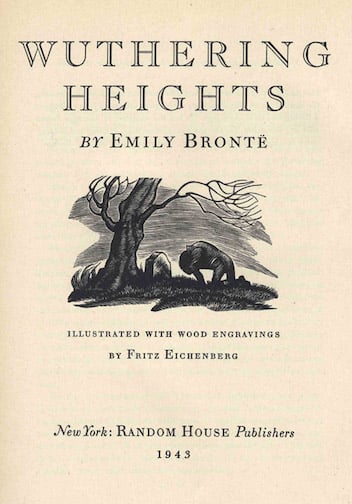Catherine and Heathcliff: A Study of Extreme Love in Wuthering Heights
By Evan Atlas | On February 3, 2024 | Updated April 27, 2024 | Comments (0)

Catherine and Heathcliff in the story of Wuthering Heights (1847) by Emily Brontë are unhesitatingly certain of their soul connection.
I’d venture to guess that some people who say they have identified their twin flame are experiencing some kind of unhealthy, obsessive, and delusional form of love.
However, some of them may be experiencing something closer to amigeist — an intense, perhaps spiritual, bond which tends towards the exaltation of all. There is an undecidability here which gives love both its healing touch and jagged edge.
This analysis is excerpted from Essence of Extreme Love by Evan Atlas. Reprinted by permission.
Limerence, amigeist, and twin flames
Catherine: “Whatever our souls are made of, his and mine are the same.”
What do we say about it from the outside? Such cases inspire or forewarn us, depending who you ask. Other characters in the novel express their own concerns.
Nelly: “The two, to a cool spectator, made a strange and fearful picture.”
Emily Brontë’s depiction of Catherine and Heathcliff has much in common with the themes of limerence, amigeist, twin flames, and extreme love in general.
It might be up to the reader to decide for themselves which of these phenomena best describes these lovers. And, as we’ve done so far, we should look at this story and the twin flame idea as opportunities for reflections on the metaphysics of love.
The juxtaposed relationships which Catherine has with Edgar and Heathcliff creates insights about how extreme love might differ from romantic love in general. In one scene, for example, Catherine asks Nelly who she should marry, and they consider the diverging paths her life might take.
‘First and foremost, do you love Mr. Edgar?’
‘Who can help it? Of course I do,’ she answered.
‘Why do you love him, Miss Cathy?’
‘Nonsense, I do — that’s sufficient.’
‘By no means; you must say why?’
‘Well, because he is handsome, and pleasant to be with.’
‘Bad!’ was my commentary.
And because he is young and cheerful.’
‘Bad, still.’
‘And because he loves me.’
‘Indifferent, coming there.’
‘And he will be rich, and I shall like to be the greatest woman of the neighbourhood, and I shall be proud of having such a husband.’
‘Worst of all … And now, let us hear what you are unhappy about. Your brother will be pleased; the old lady and gentleman will not object, I think; you will escape from a disorderly, comfortless home into a wealthy, respectable one; and you love Edgar, and Edgar loves you. All seems smooth and easy: where is the obstacle?’
‘HERE! and HERE!’ replied Catherine, striking one hand on her forehead, and the other on her breast: ‘in whichever place the soul lives. In my soul and in my heart, I’m convinced I’m wrong!’”
Catherine and Edgar
Catherine marries Edgar, even though she is convinced that on some level it is wrong. Practically, there are many things we could say about this—many in defense of Catherine’s choice.
Metaphysically, the choice embodies disharmony and incompleteness; it might even be called a revolt. It also highlights how we choose some relationships, and are given others. From “Representations of Lovesickness in Victorian Literature” by Hatice Övgü Tüzün:
“For Catherine, the enduring love she feels for Heathcliff cannot be reduced to what one may call romantic infatuation as it is rooted in her own being. The everlastingness of this kind of intense soul-to-soul connection can be effectively contrasted with the ephemeral quality of the ‘love’ she has for her husband Edgar.
It is also important to note that Catherine’s love for Heathcliff is a source of ecstatic transcendence which annihilates ego boundaries and takes her to the realm of non-dualistic awareness.
Such a heightened cognitive/emotional state makes the thought of a life without Heathcliff utterly unbearable and brings her to the brink of complete breakdown. For Catherine, letting go of Heathcliff completely is not only unbearable but also impossible since she believes that the bond that unites them is impervious to worldly conditions or interventions.”
. . . . . . . . .

The 1939 film adaptation of Wuthering Heights
. . . . . . . . .
Is Heathcliff mad? Is he a devil?
For Heathcliff’s part in all of this, there is no doubt that he is the most disliked person within the world of the book. Even Isabella, his wife, wonders: “Is Mr. Heathcliff a man? If so, is he mad? And if not, is he a devil?” And he ends up committing heinous, cruel acts throughout the book.
This orientation is at least understandable—not to say it justifies his actions—if we apply a lens which Elie Wiesel (as well as others before him) have expressed, that “the opposite of love is not hate, it is indifference.” Perhaps there is a warm glowing kernel of love within hate—a lingering heat which is not extinguished by animosity or even death.
Heathcliff and Catherine never fully connect. And love denied is not nothing; Heathcliff is incapable of indifference, but capable of having his love twisted into something inwardly tortuous and outwardly destructive.
If we are reading Wuthering Heights as philosophical fiction, then I think it is telling us that the twin flame connection is real in some sense. What is it exactly? We are still trying to figure that out. But, subjectively, it manifests in Catherine and Heathcliff as being inseparable (even though they are separate in many practical and physical ways for much of their lives).
Catherine and Heathcliff, inseparable even in death
Inseparability should be taken quite seriously as a feature of extreme love. Brontë’s “love realism” is evident in the book’s narrative structure: Catherine dies halfway through, and yet there is no doubt that her love story with Heathcliff continues. He seems to make absolutely sure of this with his parting words to her.
Heathcliff: “And I pray one prayer—I repeat it till my tongue stiffens—Catherine Earnshaw, may you not rest as long as I am living; you said I killed you—haunt me, then! The murdered do haunt their murderers, I believe. I know that ghosts have wandered on earth. Be with me always—take any form—drive me mad! Only do not leave me in this abyss, where I cannot find you! Oh, God! it is unutterable! I cannot live without my life! I cannot live without my soul!”
If these two lived today, would they be taken in by some cult which promises divinely-sanctioned, soul-unifying love? This is a possibility—the abuse of power always is. But I also have the intuition that, whatever the outward story may be (such as having a soulmate, twin flame, astrological alignment, etc.), we are giving imperfect names to real experiences.
These concepts should neither be entirely dismissed nor uncritically accepted. Personally, I also lean towards naturalistic explanations of phenomena. So I choose to see the reality and value in ideas like twin flames rather than focus on the question of whether or not I may literally have a soul which is connected to another soul.
Likewise, Catherine and Heathcliff did not need science or philosophy to know they were in anguish. A pragmatic approach to extreme love can get us quite far while we find our way through a labyrinth of unanswered questions.
All I really need to know is that people have a capacity for love, extremism, and extreme love; I should take into account that if one “looks in” on relationships like the one between Catherine and Heathcliff, many aspects of it can appear insane and, accordingly, experiencing what I subjectively identify as extreme love should be connected with mentally updating the likelihood that I could be experiencing something insidiously detrimental — something which wears a mask and convinces me of its benevolence.
But if I reason that I am experiencing something like the twin flame connection or amigeist, rather than some kind of self-incendiary obsessional fantasy, then I may reasonably pursue that extreme love as both a personally coherent goal and an experience of unity with every other act of love which is pulling us towards perfection.
. . . . . . . . .
Contributed by Evan Atlas. Evan is a writer and political philosopher from New York’s Hudson Valley. His work confronts our most significant challenges, and develops a theory of change for the 21st century that is unlike anything you’ve heard before. He believes that the future of humanity can be more loving, more free, and more beautiful, but that this future is in danger. Join him at evanatlas.com and on his Substack and help create a more beautiful planet.
. . . . . . . .

See also:
Virginia Woolf’s Analysis of Jane Eyre and Wuthering Heights
. . . . . . . .
Leave a Reply